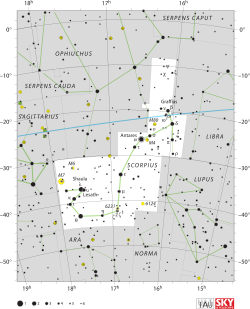18 விருச்சிக விண்மீன்
| நோக்கல் தரவுகள் ஊழி J2000.0 Equinox J2000.0 | |
|---|---|
| பேரடை | விருச்சிக விண்மீன் குழாம் |
| வல எழுச்சிக் கோணம் | 16h 15m 37.26946s[1] |
| நடுவரை விலக்கம் | –08° 22′ 09.9870″[1] |
| தோற்ற ஒளிப் பொலிவு (V) | 5.503[2] |
| இயல்புகள் | |
| விண்மீன் வகை | G2 Va |
| U−B color index | +0.18[3] |
| B−V color index | +0.64[3] |
| மாறுபடும் விண்மீன் | Sun-like[4] |
| வான்பொருளியக்க அளவியல் | |
| ஆரை வேகம் (Rv) | +11.6[2] கிமீ/செ |
| Proper motion (μ) | RA: 230.77[1] மிஆசெ/ஆண்டு Dec.: -495.53[1] மிஆசெ/ஆண்டு |
| இடமாறுதோற்றம் (π) | 71.94 ± 0.37[1] மிஆசெ |
| தூரம் | 45.3 ± 0.2 ஒஆ (13.90 ± 0.07 பார்செக்) |
| தனி ஒளி அளவு (MV) | 4.77[2] |
| விவரங்கள் | |
| திணிவு | 1.02 ± 0.03[5] M☉ |
| ஆரம் | 1.010 ± 0.009[5] R☉ |
| மேற்பரப்பு ஈர்ப்பு (மட. g) | 4.45[6] |
| ஒளிர்வு | 1.058 ± 0.028[7] L☉ |
| வெப்பநிலை | 5,433 ± 69[7] கெ |
| சுழற்சி | 22.7 ± 0.5[8] |
| அகவை | 4.1–5.3[9] பில்.ஆ |
| தரவுதள உசாத்துணைகள் | |
| SIMBAD | data |
| NStED | data |
18 விருச்சிக விண்மீன் (18 Scorpii) என்பது விருச்சிக விண்மீன் குழாத்திலுள்ள ஒரு தனி விண்மீன் ஆகும். இதன் தோற்ற ஒளிப்பொலிவெண் 5.5[2]. இது தோரயமாக 45.3 ஒளியாண்டுகள் துரத்தில் உள்ளது. இதை வெறும் கண்ணால் காண முடியும்.
18 விருச்சிக விண்மீன், பல பண்புகளில் சூரியனை போன்றே உள்ளது. காய்றேல் டி ச்டோபெல் (1996) தனது மறு ஆய்வில் இதை உறுதி செய்துள்ளார்[10].எனவே விஞ்ஞானிகள் இதற்கு அருகிலுள்ள கோள்களில் உயிரினங்கள் வாழ்வதற்கு அதிக வாய்ப்புள்ளதாக கருதுகிறார்கள். ஆனால் இதுவரை இதன் அருகில் எந்தக் கோளும் கண்டறியப்படவில்லை.
பண்புகள்[தொகு]
18 விருச்சிக விண்மீனின் விண்மீன் வகைப்பாடு G2 Va[11]. இதில் ‘V’ என்பது ஹைட்ரஜன் அணுக்களின் அணுக்கரு இணைவு மூலம் ஆற்றலை உருவாக்குகிறது என்பதை குறிக்கும். இதன் ஆரத்தை குறுக்கீட்டுமானி மூலம் அளந்ததில், இது 101% சூரிய ஆரம் உடையது அதாவது சூரியனை விட சற்று பெரிதானது என அறிந்துள்ளனர். இதன் நிறையை அளந்ததில் இது சூரியனைப் போன்று 102% மடங்கு நிறை உடையது[5] எனவும், இதன் ஒளிர்வு (luminosity) 106% சூரியனைப் போன்று உள்ளது எனவும் அறிந்துள்ளனர். இதன் வெளிப்புற வெப்பநிலை 5,433 கெல்வின் [7].
மேற்கோள்கள்[தொகு]
- ↑ 1.0 1.1 1.2 1.3 1.4 van Leeuwen, F. (November 2007), "Validation of the new Hipparcos reduction", Astronomy and Astrophysics, 474 (2): 653–664, arXiv:0708.1752, Bibcode:2007A&A...474..653V, doi:10.1051/0004-6361:20078357
- ↑ 2.0 2.1 2.2 2.3 Nordström, B.; et al. (May 2004), "The Geneva-Copenhagen survey of the Solar neighbourhood. Ages, metallicities, and kinematic properties of ˜14 000 F and G dwarfs", Astronomy and Astrophysics, 418: 989–1019, arXiv:astro-ph/0405198, Bibcode:2004A&A...418..989N, doi:10.1051/0004-6361:20035959
- ↑ 3.0 3.1 "18 Sco -- Variable Star", SIMBAD, Centre de Données astronomiques de Strasbourg, பார்க்கப்பட்ட நாள் 2011-10-13 The ubv information is per Compilation of Eggen's UBV data, transformed to UBV (unpublished) 1986. See the Measurements section.
- ↑ Hall, Jeffrey C.; et al. (July 2009), "The Activity and Variability of the Sun and Sun-Like Stars. II. Contemporaneous Photometry and Spectroscopy of Bright Solar Analogs", The Astronomical Journal, 138 (1): 312–322, Bibcode:2009AJ....138..312H, doi:10.1088/0004-6256/138/1/312
- ↑ 5.0 5.1 5.2 Bazot, M.; et al. (February 2011), "The radius and mass of the close solar twin 18 Scorpii derived from asteroseismology and interferometry", Astronomy and Astrophysics, 526, arXiv:1209.0217, Bibcode:2011A&A...526L...4B, doi:10.1051/0004-6361/201015679
- ↑ Sousa, S. G.; et al. (August 2008), "Spectroscopic parameters for 451 stars in the HARPS GTO planet search program. Stellar [Fe/H] and the frequency of exo-Neptunes", Astronomy and Astrophysics, 487 (1): 373–381, arXiv:0805.4826, Bibcode:2008A&A...487..373S, doi:10.1051/0004-6361:200809698
- ↑ 7.0 7.1 7.2 Boyajian, Tabetha S.; et al. (February 2012), "Stellar Diameters and Temperatures. I. Main-sequence A, F, and G Stars", The Astrophysical Journal, 746 (1): 101, arXiv:1112.3316, Bibcode:2012ApJ...746..101B, doi:10.1088/0004-637X/746/1/101. See Table 10.
- ↑ Coughlin, Jared; et al. (January 2010), "The Night Time Sun: X-Ray Observations of the Solar Twin 18 Scorpii", Bulletin of the American Astronomical Society, 42: 333, Bibcode:2010AAS...21542417C
- ↑ Mamajek, Eric E.; Hillenbrand, Lynne A. (2008), "Improved Age Estimation for Solar-Type Dwarfs Using Activity-Rotation Diagnostics", The Astrophysical Journal, 687 (2): 1264–1293, arXiv:0807.1686, Bibcode:2008ApJ...687.1264M, doi:10.1086/591785
- ↑ Cayrel de Strobel, G. (1996), "Stars Resembling the Sun", The Astronomy and Astrophysics Review, 7 (3): 243–288, Bibcode:1996A&ARv...7..243C, doi:10.1007/s001590050006
- ↑ Porto de Mello, G. F.; da Silva, L. (1997), "HR 6060: The Closest Ever Solar Twin?", The Astrophysical Journal, 482 (2): L89–L92, Bibcode:1997ApJ...482L..89P, doi:10.1086/310693

